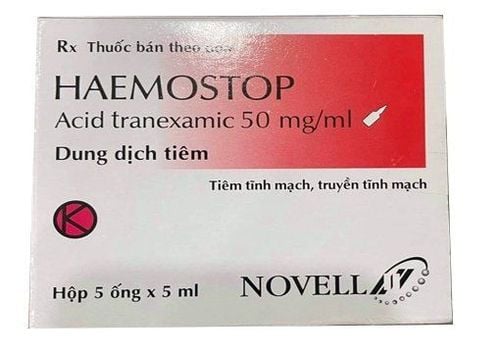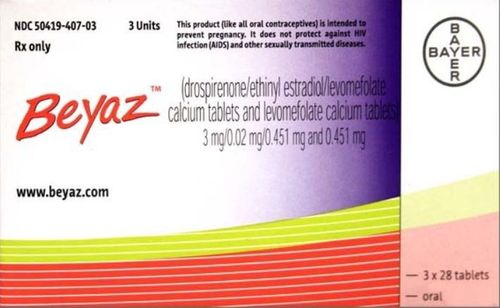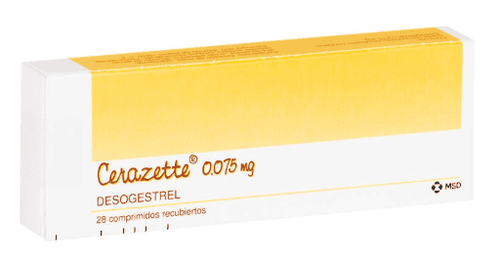This is an automatically translated article.
Tranbleed 1000 drug belongs to the group of drugs that act on blood, the drug is prepared in the form of an injection solution packed in a box of 5 ampoules or 10 ampoules x 10ml. Tranbleed 1000 has the main ingredient is Tranexamic Acid 1000 mg. So how to use the drug and what are the precautions when using Ranbleed 1000?
1. What is the effect of Tranbleed 1000?
Tranbleed 1000 is used in the following cases:
Abnormal bleeding during and after surgery, kidney bleeding, nose bleeding, prostate disease, obstetrics and gynecology, urology. Treatment of hemorrhagic disease, polymenorrhea Hemolysis due to pulmonary tuberculosis
2. Dosage - How to use Tranbleed 1000
2.1. Tranbleed 1000 is used for slow intravenous injection or intravenous infusion after dilution with 0.9% NaCL, 5% Glucose, Ringer solution to 1% or 2% tranexamic acid. The recommended rate of intravenous or intravenous infusion of Tranexamic acid is 50 mg/min. Means:
Intravenous administration of Tranbleed solution 0.5ml/min undiluted. Intravenous infusion of Tranbleed 1% solution after dilution is 5ml/min. Intravenous infusion of Tranbleed 2% solution after dilution is 2.5ml/min. For elderly patients undergoing cardiac surgery, the recommended prolonged intravenous infusion is 4.5 mg/kg body weight/hour.
2.2. Dosage Dosage will depend on the condition of the disease and different people will have different specific dosages.
Systemic fibrinolysis:
Slow intravenous injection 3 times/day with a dose of 0.5 - 1g Tranexamic acid equivalent to 5 - 10ml Tranbleed 1000 or 10mg/kg body weight. An intravenous infusion dose of 25-50mg/kg body weight/day can be used. Children can be given a dose of 10mg/kg body weight intravenously for 2 03 days depending on the effectiveness of treatment. Prostate removal procedure in men:
Use 5-10ml of Tranbleed 1000 intravenously 2-3 times a day. The first dose is given during surgery, then the next dose is given during the first 3 days of surgery. Patients take 2-3 tablets of 1g from 2 to 3 times a day until no more hematuria. Dental surgery:
Use Tranexamic acid immediately before surgery with an intravenous dose of 10mg/kg body weight. After surgery, a dose of 25mg/kg body weight can be used. Can be used in combination with coagulation factors. Cardiovascular surgery:
Adults: After anesthesia and skin incision, the first dose of surgery is 15mg/kg body weight. Thereafter, a further intravenous infusion of 4.5 mg/kg/h during surgery and a dose of 0.6 mg/kg can be used to add to the cardiopulmonary priming volumes. Children > 2 years: After anesthesia and skin incision, use the first surgical dose of 10mg/kg body weight. During surgery, intravenous infusion or bolus dose of 10mg/kg can be used. Patients with liver or kidney disease: Dosage adjustment of Tranbleed 1000 is required based on creatinine clearance.
3. Contraindications to using Tranbleed 1000
Tranbleed 1000 should not be used in the following cases:
Patients with hypersensitivity to tranexamic acid or to any of its ingredients. The patient has a history of blood clots (thrombosis). Cases of central nervous system bleeding, subarachnoid hemorrhage, central nervous system surgery or other cases of brain bleeding.
4. Tranbleed 1000 . drug interactions
Tranbleed 1000 when combined with some of the following drugs may have drug interactions such as:
Oral contraceptives containing Estrogen. Medicines that prevent blood clotting (thrombolytics). Tretinoin oral medication. Penicillin-containing solutions should not be mixed with Tranexamic acid or with blood for transfusion. For intravenous infusion, Tranbleed 1000 injection solution can be mixed with solutions for injection such as: Glucose 5%, Sodium chloride (0.9%) or Ringer electrolyte solution. Heparin and Tranexamic acid can be added to the same infusion solution.
5. Side effects when using Tranbleed 1000
During the use of Tranbleed 1000, patients may experience some unwanted side effects such as:
Common:
Digestive disorders: Diarrhea with nausea and vomiting. Body as a whole: Dizziness. Uncommon:
Circulatory: After intravenous administration, hypotension may occur. Rare:
Eyes: Altered color perception. Central nervous system: ischemia, cerebral infarction, headache, hydrocephalus, dizziness, convulsions (especially in cases of drug abuse).
6. Precautions when using Tranbleed 1000
Here are some precautions for patients before taking Tranbleed 1000.
Use Tranbleed 1000 with caution if the patient already has blood in the urine because it can lead to urinary tract obstruction. With caution in patients with a risk of excessive blood clots or systemic bleeding, Tranexamic acid may not be suitable, except in patients primarily due to disorders of the fibrinolytic mechanism. With caution in patients with a history of convulsions, Tranexamic Acid should not be used. With caution in patients on long-term treatment with Tranexamic Acid Injection, if color vision disturbances appear, the drug should be discontinued. With long-term continuous use of the drug, patients need regular ophthalmological examinations are indicated. With pathological changes in the eyes, especially retinal diseases, the doctor must make a decision to use Tranbleed 1000 long-term or not. In case the patient has renal failure, the dose of Tranexamic Acid will be adjusted to suit the patient's condition. If you are pregnant or breast-feeding, consult your doctor or pharmacist for advice before taking Tranbleed 1000. Tranexamic Acid has been reported to be excreted in human milk. Therefore, Tranbleed 1000 is not recommended during lactation. Tranexamic acid has an effect on the ability to drive and use machines, so you should not drive or operate machinery while being treated with Tranexamic Acid. Intravenous injection must be performed at a very slow rate, intramuscular injection is not recommended. In case of renal failure, the dose of Tranexamic acid should be adjusted because there is a risk of accumulation of Tranexamic acid. Tranbleed 1000 intravenous infusion should not be used in children under 2 years of age because there are no accurate data on the safety and effectiveness of this drug. Hopefully with the information provided above, patients can have more useful information about the Tranbleed 1000 drug line. Patients should always strictly adhere to the medication instructions from doctors and pharmacists before taking the medicine. Using Tranbleed 1000 drug, absolutely do not arbitrarily buy medicine to self-treat, it may cause unwanted side effects that affect health.
Please dial HOTLINE for more information or register for an appointment HERE. Download MyVinmec app to make appointments faster and to manage your bookings easily.













